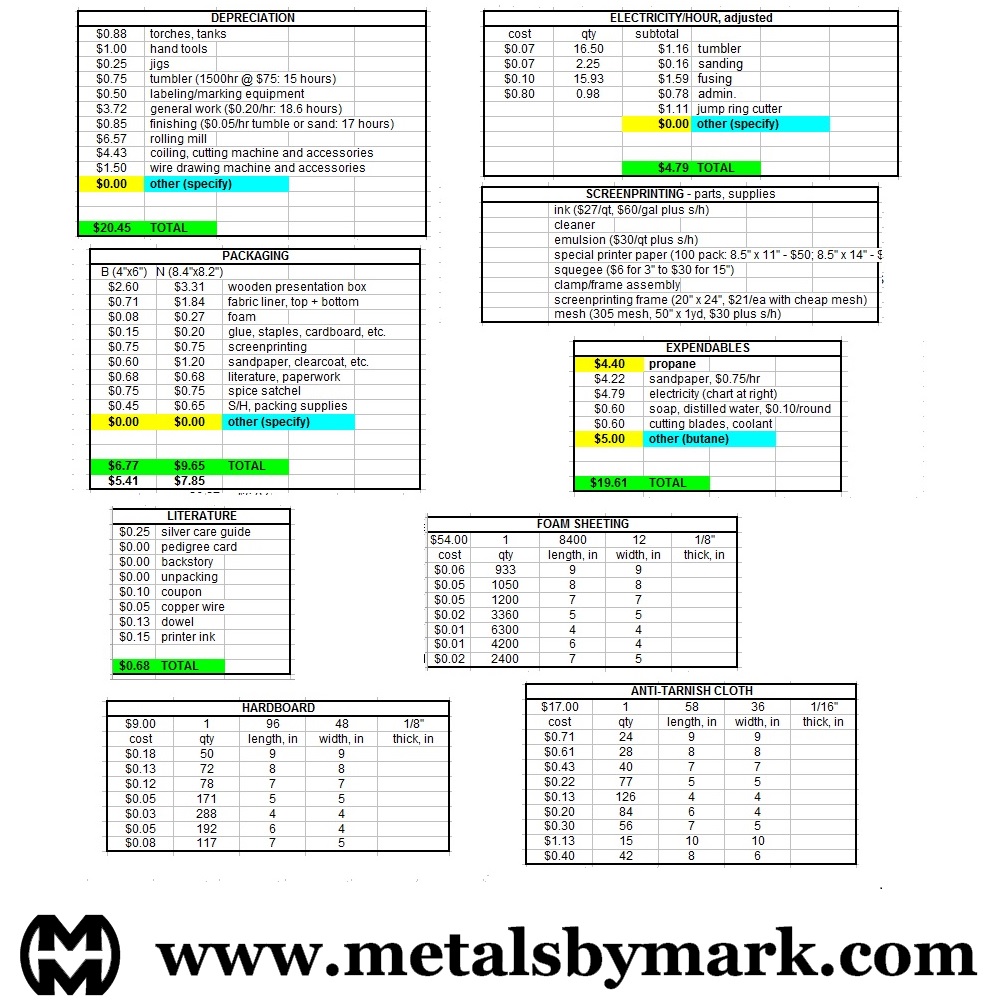
Material calculations
Some, but not all
Categories: Instruction and information; Commerce and business
Word count/read time: 450 words; 2 minutes
Part two of this three-part series deals with the cost of materials.
Materials are everything used in an item's production including
expendables like paper towels and electricity.
All manufacturing must also account for depreciation and it's more accurately categorized in materials
as opposed to labor.
Most chainmakers buy pre-made jump rings and pre-made findings to make manufacturing easier
and quicker. The cost is the price paid for the
various findings and jump rings with no further math required.
A few sets of pliers will get the job done; though some are expensive,
depreciation is minimal as they last a long time.
Going a step further would be buying wire or raw metal and making the jump rings
and/or findings, which will use electricity and other supplies. More tools would be
added to the fray (mandrels, cutting implements, coil winding mechanism, etc.) so
depreciation would increase proportionately.
Neither situation fully describes my methods. I make everything from scrap metals
mined from the internet or yard sales. To those prices I add electricity and supplies
associated with refining them to 0.999 purity.
Depreciation is a bit more complicated. It includes the refiner (power source, electrodes,
filters, handling equipment, etc.), furnace (crucibles, tongs, scoopers, ingot molds, torches,
etc.), hammer forging equipment, rolling mill, wire drawing equipment, torches, coiling machine,
jump ring cutter, and myriad hand tools. I weld or solder basically every jump ring so
that adds additional costs: gas and/or electricity for the torch(es), solder or filler
metal, flux, sandpaper.
With a completed piece come additional steps that some people skip or minimize. I tumble
my items for many hours over several sessions. Each session uses distilled water, soap,
and perhaps a burnishing agent. Supplies and electricity, in other words, and more time.
Hallmarking stamps last a very long time but they must be depreciated; custom
stamps can be several hundred dollars apiece!
Packaging costs are a line item. I make custom wooden presentation cases. I need to know
their cost start to finish: case, paint, anti-tarnish fabric, adhesives, literature,
etc. I re-use peanuts and bubble wrap along with other
shipping materials to reduce costs and waste.
General business expenses include advertising, website, literature, licenses, rent, booth
space, travel, freebies, swag, and more. Being a one-person operation means understanding
basic accounting to wrangle all the figures. There are many calculations to reach the bottom
line. Plus, whatever number pops out of the equation needs to be competitive.
You can stick to the "twice material cost" formula and treat it like a hobby
or approach it like a business and figure out all the costs. Hobby or profession, don't undercut
or undervalue your talents and products because it does favors to no one.
Posted by M: May 9, 2019
Please email any thoughts or comments regarding this post.
Comment Section
NOTE: Your comments will be included in this section
as long as they aren't illegal. This section is censor-free so show me
your intelligence or ignorance and everything in between!
|
2026
Review: Commarker Titan 1
Pesky Descriptors
Top Purchases 2025
2025
2024
2023
2022
2021
2020
2019
2018
2017
2016
2015
2014
|